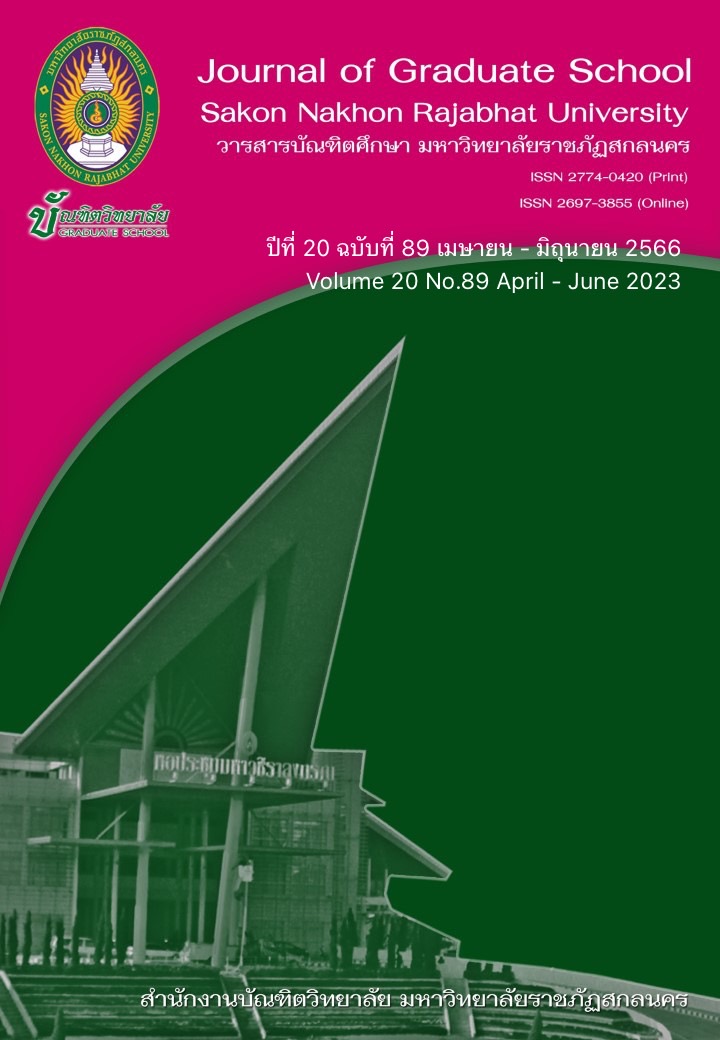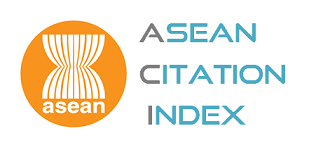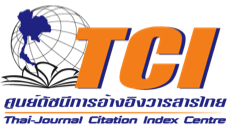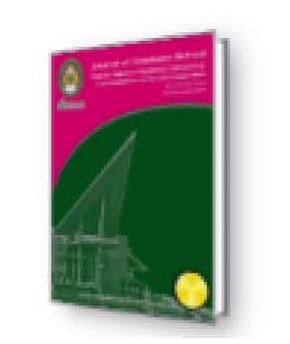การพัฒนาการจัดการเรียนการสอนด้วยการสอนเป็นทีม
Keywords:
Team-Teaching Approach, Design ThinkingAbstract
The research objectives were to 1) examine conditions and problems of teaching and learning management, 2) design and develop teaching and learning management based on the collaborative team teaching approach, and 3) explore student satisfaction toward the developed teaching and learning management based on the collaborative team teaching approach. The participants of this study were selected through purposive sampling, including nine teachers and 250 students who enrolled in the Thai Society and Globalization course at Sakon Nakhon Rajabhat University in the second semester of the academic year 2021, yielding a total of 259 participants. The research instrument was a set of questionnaires. The data were analyzed by using content analysis, mean, percentage, and standard deviation.
The research findings indicated that the current teaching and learning conditions were influenced by past educational practices. A majority of the problems stemmed from unsystematic practices, a lack of diversity in teaching approaches, and a compartmentalized teaching and learning system, which resulted in the uneven distribution of knowledge among students. Teachers were also compelled to teach topics outside their areas of expertise. In addition, the course content was inflexible and limited in its scope, leading to insufficient knowledge acquisition among students and hindered the development of other skills, such as evaluation and measurement, which were inconsistent with the course objectives, and student needs. The budget allocated to these activities was also insufficient, which impacted the provision of management services, and teaching and learning initiatives.
Based on the mentioned problem above, the researcher has developed a teaching model to address the issues using the ADDIE model as a framework for designing the learning process. The Collaborative Team-Teaching Approach (CTTA) was created, integrating the team-teaching approach with the design thinking process and a double-diamond design. The developed teaching model was implemented on the target audiences, and after the intervention, the results indicated a high level of student satisfaction with the teaching and learning management utilizing the team-teaching approach ( = 4.20), with the teacher aspect reaching the highest level. When considering each aspect, the teaching team was found to be approachable, attentive, and conducive to student input at the highest level (
=4.30).
References
กัลยา ตันติยาสวัสดิกุล. (2565). กระบวนการคิดเชิงออกแบบสำหรับการแก้ปัญหาอย่างสร้างสรรค์. กรุงเทพฯ: คอร์ปอเรชั่นโฟร์ดี.
จิราวรรณ คุ้มพร้อม สำลีพันธ์. (2561). ผลการจัดการสอนแบบทีมต่อการสร้างจิตสำนึกใน การจัดการขยะของนักเรียนในโรงเรียนประถมศึกษา อำเภอเกาะสมุย จังหวัดสุราษฎร์ธานี. วารสารนาคบุตรปริทรรศน์ มหาวิทยาลัยราชภัฏนครศรีธรรมราช, 10(6-9), 222-235.
ชรพล วิบูลยศริน. (2557). หลักการออกแบบการสอนบนเว็บตามแบบจำลอง ADDIE เพื่อการสอนสนทนาภาษาไทยเบื้องต้น สำหรับชาวต่างประเทศ. วารสารศรีนครินทรวิโรฒวิจัย และพัฒนา (สาขามนุษยศาสตร์และสังคมศาสตร์), 6(12), 192-204.
ชุลีรัตน์ เจริญพร. (2553). การสำรวจสภาพการณ์และปัญหาเพื่อการพัฒนาหลักสูตรหมวดวิชาศึกษาทั่วไป. ปทุมธานี: มหาวิทยาลัยรังสิต.
ทิศนา แขมมณี และคณะ. (2544). กระบวนการเรียนรู้. กรุงเทพฯ: บริษัทพัฒนาคุณภาพวิชาการ (พว.).
ลินดา เกณฑ์มา. (2558). การศึกษาสภาพและความต้องการในการจัดการเรียนการสอนวิชาศึกษาทั่วไปตามกรอบมาตรฐานคุณวุฒิ ระดับอุดมศึกษาแห่งชาติในมหาวิทยาลัยราชภัฏบ้านสมเด็จเจ้าพระยา. วารสารสารสนเทศ, 14(1-6), 69-81.
วันชัย แก้วดี. (2549). การพัฒนาทักษะการเรียนรู้เป็นทีมในชั้นเรียน สำนักวิทยาบริการ มหาวิทยาลัยเทคโนโลยีราชมงคลธัญบุรี. เข้าถึงได้จาก http://www.blog.rmutt.ac.th/?p=157. 20 มิถุนายน 2565.
วาสนา ดอนจันทร์ทอง. (2556). ความคิดเห็นของอาจารย์และนักศึกษามหาวิทยาลัยราชภัฏจันทรเกษมที่มีต่อการเรียนการสอนระบบกลุ่มใหญ่ กลุ่มวิชาภาษาหมวดวิชาศึกษาทั่วไป. กรุงเทพฯ: คณะมนุษยศาสตร์และสังคมศาสตร์ มหาวิทยาลัยราชภัฏจันทรเกษม.
วิชัย วงษ์ใหญ่. (2537). กระบวนการพัฒนาหลักสูตรและการสอน : ภาคปฏิบัติ. กรุงเทพฯ: สุวีริยาสาส์น.
วิรไท สันติประภพ. (2563). รับมืออย่างไรเมื่อมหาวิทยาลัยกำลังถูกดิสรัปต์. เข้าถึงได้จาก https://thaipublica.org/2020/11/veerathai-49/. 20 มิถุนายน 2565.
สำนักงานคณะกรรมการอุดมศึกษา. (2552). กรอบมาตรฐานคุณวุฒิระดับอุดมศึกษาแห่งชาติ พ.ศ. 2552. กรุงเทพฯ: กระทรวงศึกษาธิการ.
อรนิภา ไทยแท้. (2561). ผลการใช้รูปแบบการสอนเป็นทีมระหว่างครูไทยกับครูต่างชาติแบบการแบ่งหน้าที่อย่างเท่าเทียมกันในบริบทการสอนคณิตศาสตร์ ในห้องเรียนสองภาษาของนักเรียนระดับมัธยมศึกษาปีที่ 4. วิทยานิพนธ์ กศ.ม. กรุงเทพฯ: มหาวิทยาลัยธรรมศาสตร์.
อรอนงค์ โฆษิตพิพัฒน์. (2560). การพัฒนาความสามารถในการทำงานเป็นทีมด้วยรูปแบบการสอนแบบร่วมมือทำงานเป็นทีมในรายวิชาสัมมนาวารสารศาสตร์. วารสารครุพิบูล, 5(1-6), 77-86.
Branch, R.M. (2009). Instructional Design: The ADDIE Approach. New York: Springer.
Buckley, Francis J. (2000). Team Teaching: What, why, and how?. California: SAGE Publications, Inc.
Doorley, S., Holcomb, S., Klebahn, P., Segovia,K., & Utley, J. (2018). Design Thinking Bootleg.d. School. Retrieved from https://dschool.stanford.edu/resources/design-thinking-bootleg. June 21st, 2022.
Fullan, M., & Hargeaves, A. (2013). Teacher development and educational change. London: Routledge.
Leclerc, M., Moreau, A. C., Dumouchel, C., & Sallafranque-St. Louis, F. (2012). Factors that promote progression in schools functioning as professional learning community. International Journal of Education Policy & Leadership, 7(7), 1-14.
Linder, R. A., Post, G., & Calabrese, K. (2012). Professional learning communities: Practices for successful implementation. Delta Kappa Gamma Bulletin, 78(3), 13-22.
Downloads
Published
How to Cite
Issue
Section
License
Copyright (c) 2023 Journal of Graduate School Sakon Nakhon Rajabhat University

This work is licensed under a Creative Commons Attribution-NonCommercial-NoDerivatives 4.0 International License.
บทความทุกบทความที่ตีพิมพ์ในวารสารบัณฑิตศึกษา มหาวิทยาลัยราชภัฏสกลนคร ถือว่าเป็นลิขสิทธิ์ของบัณฑิตวิทยาลัย มหาวิทยาลัยราชภัฏสกลนคร










